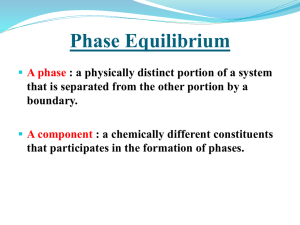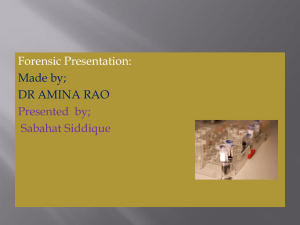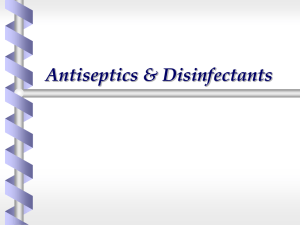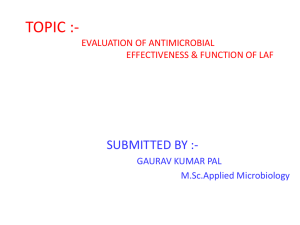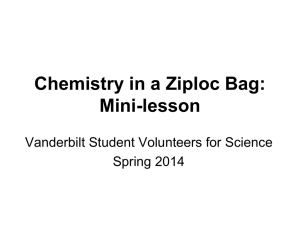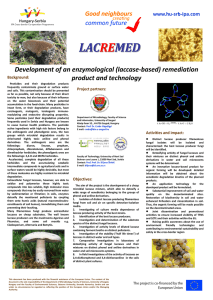Phenol and water system
advertisement
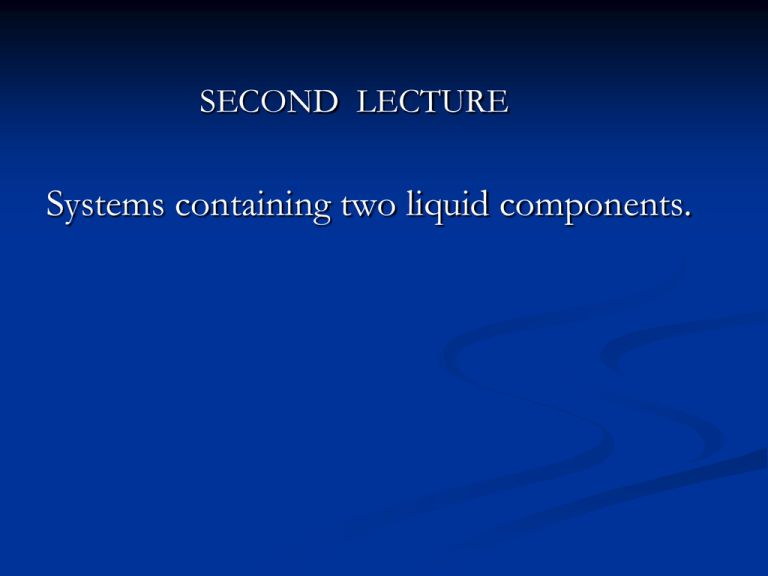
SECOND LECTURE Systems containing two liquid components. Two Component Systems Containing Liquid Phases: miscible partially miscible immiscible ethyl alcohol and water phenol and water water and mercury Phenol and water system: miscible Partially miscible Two factors affecting misciblity 1- Concentration of phenol in water. 2- Temperature. Two component systems: Phenol Phenol / water water The curve g b h c i shows limits of temperature and concentration within which two liquid phases exist in equilibrium. 2 phases 1 phase Point A 100% water 10 % phenol 11 % phenol water rich phase contains water+ phenol(11%) Phenol rich phase contains Phenol (63%)+ water > 63 % phenol 1 phase 24% phenol The curve g b h c i shows limits of temperature & concentration within which two liquid phases exist in equilibrium. Point A 100% water (pure water) Phenol Point B (11 % phenol) 2 phases water rich phase& phenol rich phase More Phenol Point C ( >63% phenol) 1 phase Completely miscible The Tie Line It is always parallel to the base line in two component systems. All systems prepared on a tie line, at equilibrium, will separate into phases of constant composition. known as conjugate phases. Any system represented by a point on the line bc , at 50oC. separates to give a pair of conjugate phases whose composition is 11% phenol in water rich phase (A) & 63 % phenol in phenol rich phase. Importance of Tie line: Calculation of the composition of each phase. Determination of the weight of each phases. (calculation of the distribution of phenol (or water) throughout the system as a whole. F = 2 - 1 +1 2 F= 2 - 2 +1 1 The use of Tie line in calculations: As an example, let us suppose that we mixed 24 g of phenol with 76 g of water, warmed the mixture to 50oC, and allowed it to reach equilibrium at this temperature. Weight phase A/weight of phase B = dc/bd =6324/24 -11=39/13 =3/1 Weight of A= ¾ x 100= 75, wt. of B = ¼ x 100= 25 Phase A=75 gm , phase B =25 gm. Amount of phenol in A=75 x 11/100= 8.25 gm Amount of phenol in B= 25 x 63/100= 15.75 gm 24 gm Application of Tie line: To formulate systems containing more than one component where it may be advantageous to achieve a single-phase product. Handling of solid phenol, a necrotic agent (caustic agent), is facilitated in the pharmacy if a solution of phenol and water is used. The most convenient formulation of a single liquid phase solution was 80% w /v, equivalent to about 76% w / w. This mixture has a freezing point of about 3.5oC The Critical Solution Temperature: CST Is the maximum temperature at which the 2-phase region exists (or upper consolute temperature). In the case of the phenol-water system, this is 66.8oC (point h) All combinations of phenol and water > CST are completely miscible and yield 1-phase liquid systems. Systems Showing a Decrease in Miscibility with Rise in Temperature: A few mixtures, exhibit a lower critical solution temperature (low CST), e.g. triethylamine plus water. The miscibility with in temperature. In the preparation of paraldehyde enemas, (consist of a solution of paraldehyde in normal saline). Cooling the mixture during preparation allows more rapid solution, and storage of enema in a cool place is recommended. Systems Showing Upper and Lower CSTs The miscibility with temp. in systems having a lower CST is not indefinite. > a certain temperature miscibility starts to again with further in temperature. Closed-phase diagram, i.e. nicotinewater system. Blending : The in miscibility of two liquids due to the addition of a third substance. Example : the formulation of solution of cresol with soap BP 1968, which contains 50% cresol. Cresol is only partially miscible with water, but the soap in this preparation decreases the upper CST and produces complete miscibility at ordinary temperature. The Effects of Added Substances on CST: Type of CST Solubility of additive in each component Effect on CST Effect on miscibility Upper Approx. equally soluble in both components Lowered Increased Raised Decreased Raised Increased Lowered Decreased Upper Lower Lower Readily soluble in one component but not in the other Approx. equally soluble in both components Readily soluble in one component but not in the other Addition of substance That equally miscible In 2 phases.
